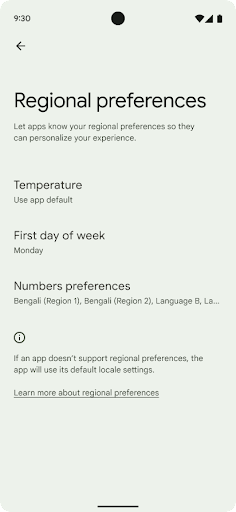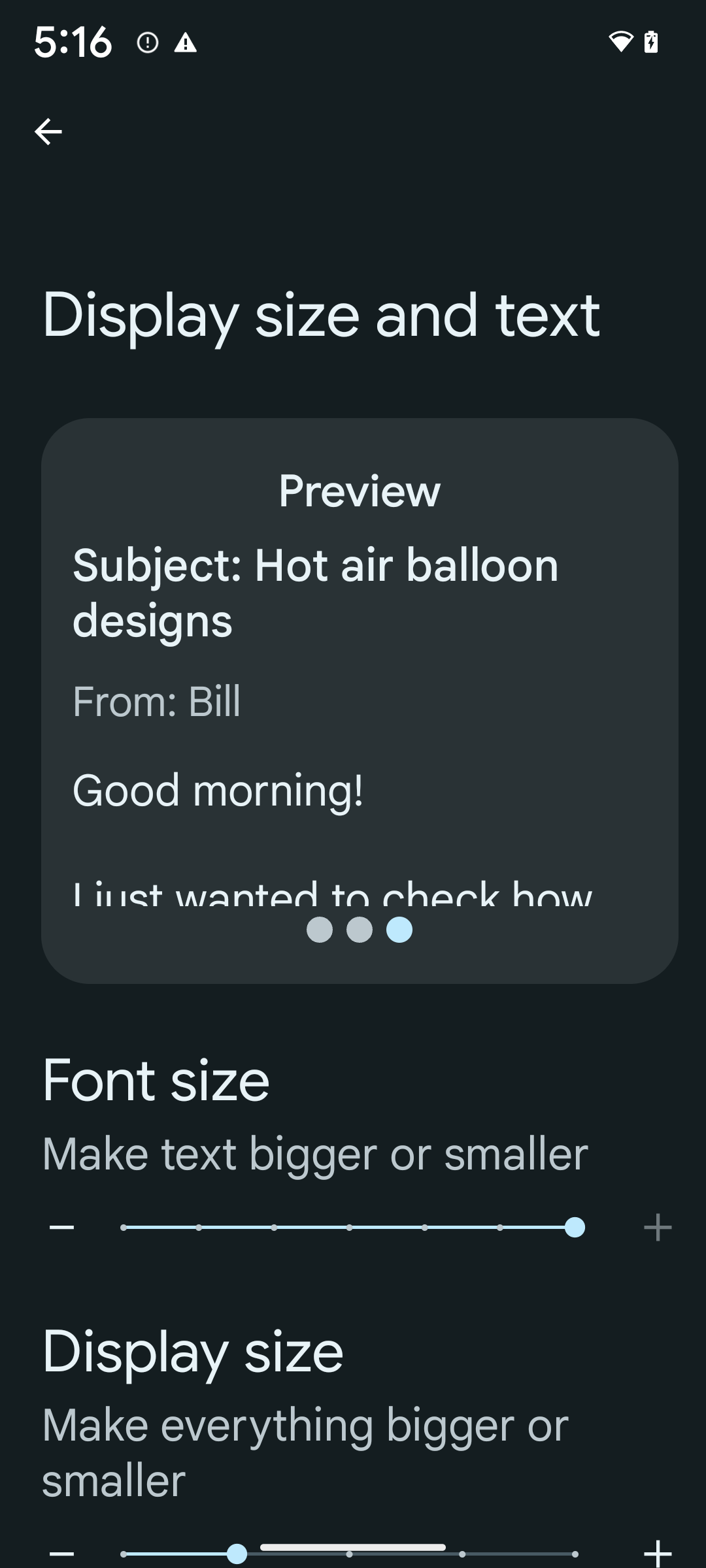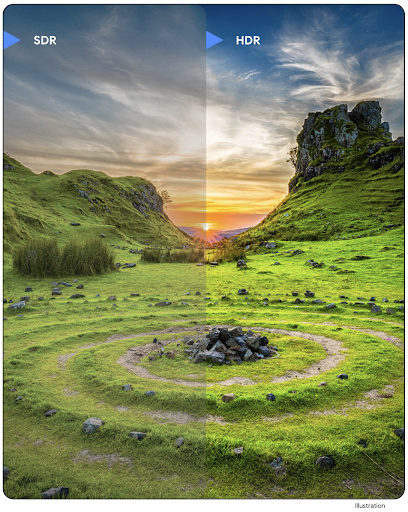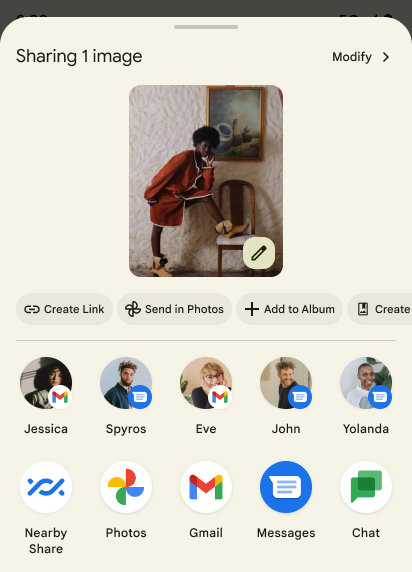Android 14에는 개발자를 위한 훌륭한 기능과 API가 도입되었습니다. 다음은 앱의 기능을 알아보고 관련 API를 시작하는 데 도움이 됩니다.
추가된 API, 수정된 API, 삭제된 API에 관한 자세한 목록은 API 차이점 보고서를 참고하세요. 추가된 API에 관한 자세한 내용은 Android API 참조를 참고하세요. Android 14의 경우 API 수준 34에 추가된 API를 찾아보세요. 플랫폼 변경이 앱에 영향을 줄 수 있는 분야에 관해 알아보려면 Android 14를 타겟팅하는 앱 및 모든 앱의 Android 14 동작 변경사항을 확인해야 합니다.
다국어 지원
앱별 언어 설정
Android 14에서는 Android 13(API 수준 33)에서 도입된 앱별 언어 기능을 다음과 같은 추가 기능으로 확장합니다.
앱의
localeConfig자동으로 생성: Android 스튜디오 Giraffe Canary 7 및 AGP 8.1.0-alpha07부터 앱이 앱별 언어 설정을 자동으로 지원하도록 구성할 수 있습니다. Android Gradle 플러그인은 프로젝트 리소스를 기반으로LocaleConfig파일을 생성하고 최종 매니페스트 파일에 이에 대한 참조를 추가하므로 더 이상 수동으로 파일을 만들거나 업데이트할 필요가 없습니다. AGP는 앱 모듈의res폴더에 있는 리소스 및 모든 라이브러리 모듈 종속 항목을 사용하여LocaleConfig파일에 포함할 언어를 결정합니다.앱의
localeConfig동적 업데이트:LocaleManager에서setOverrideLocaleConfig()및getOverrideLocaleConfig()메서드를 사용하여 기기의 시스템 설정에서 앱의 지원되는 언어 목록을 동적으로 업데이트합니다. 앱에서 현지화에 서버 측 푸시를 활용하는 경우 이러한 유연성을 사용하여 지역별 지원되는 언어 목록을 맞춤설정하거나 A/B 실험을 실행하거나 업데이트된 언어 목록을 제공합니다.입력 방식 편집기(IME)의 앱 언어 공개 상태: IME는
getApplicationLocales()메서드를 활용하여 현재 앱의 언어를 확인하고 IME 언어를 해당 언어와 일치시킬 수 있습니다.
Grammatical Inflection API
3 billion people speak gendered languages: languages where grammatical categories—such as nouns, verbs, adjectives, and prepositions—inflect according to the gender of people and objects you talk to or about. Traditionally, many gendered languages use masculine grammatical gender as the default or generic gender.
Addressing users in the wrong grammatical gender, such as addressing women in masculine grammatical gender, can negatively impact their performance and attitude. In contrast, a UI with language that correctly reflects the user's grammatical gender can improve user engagement and provide a more personalized and natural-sounding user experience.
To help you build a user-centric UI for gendered languages, Android 14 introduces the Grammatical Inflection API, which lets you add support for grammatical gender without refactoring your app.
지역 설정
Regional preferences enable users to personalize temperature units, the first day of the week, and numbering systems. A European living in the United States might prefer temperature units to be in Celsius rather than Fahrenheit and for apps to treat Monday as the beginning of the week instead of the US default of Sunday.
New Android Settings menus for these preferences provide users with a
discoverable and centralized location to change app preferences. These
preferences also persist through backup and restore. Several APIs and
intents—such as
getTemperatureUnit
and
getFirstDayOfWeek—
grant your app read access to user preferences, so your app can adjust how it
displays information. You can also register a
BroadcastReceiver on
ACTION_LOCALE_CHANGED
to handle locale configuration changes when regional preferences change.
To find these settings, open the Settings app and navigate to System > Languages & input > Regional preferences.


접근성
비선형 글꼴 크기 200%로 조정
Android 14부터 시스템은 글꼴 크기를 최대 200%까지 지원하므로 사용자에게 추가 접근성 옵션을 제공할 수 있습니다.
화면의 큰 텍스트 요소가 너무 커지지 않도록 시스템에서는 비선형 크기 조정 곡선을 적용합니다. 이 크기 조정 전략은 큰 텍스트가 작은 텍스트와 동일한 비율로 조정되지 않음을 의미합니다. 비선형 글꼴 크기 조정은 다양한 크기의 요소 간에 비례 계층 구조를 유지하는 동시에 높은 수준으로 크기가 조정되는 선형 텍스트 문제 (예: 텍스트가 잘리거나 너무 큰 디스플레이 크기로 인해 텍스트를 읽기 어려워지는 경우)를 완화하는 데 도움이 됩니다.
비선형 글꼴 크기 조정으로 앱 테스트

이미 확장 가능 픽셀 (sp) 단위를 사용하여 텍스트 크기를 정의하는 경우 이러한 추가 옵션과 크기 조정 개선사항이 앱의 텍스트에 자동으로 적용됩니다. 하지만 앱이 글꼴 크기를 올바르게 적용하고 사용성에 영향을 미치지 않으면서 더 큰 글꼴 크기를 수용할 수 있는지 확인하려면 최대 글꼴 크기 (200%)를 사용 설정하여 UI 테스트를 실행해야 합니다.
200% 글꼴 크기를 사용 설정하려면 다음 단계를 따르세요.
- 설정 앱을 열고 접근성 > 디스플레이 크기 및 텍스트로 이동합니다.
- 글꼴 크기 옵션의 경우 이 섹션에 제공되는 이미지와 같이 최대 글꼴 크기 설정이 사용 설정될 때까지 더하기(+) 아이콘을 탭합니다.
텍스트 크기에 조정된 픽셀(sp) 단위 사용
항상 sp 단위로 텍스트 크기를 지정해야 합니다. 앱에서 sp 단위를 사용하면 Android에서는 사용자의 기본 텍스트 크기를 적용하고 적절하게 크기를 조정할 수 있습니다.
패딩에 sp 단위를 사용하거나 암시적 패딩을 가정하여 뷰 높이를 정의하지 마세요. 비선형 글꼴 크기 조정 sp 치수는 비례하지 않을 수 있으므로 4sp + 20sp가 24sp와 같지 않을 수 있습니다.
조정된 픽셀(sp) 단위 변환
TypedValue.applyDimension()을 사용하여 sp 단위에서 픽셀로 변환하고 TypedValue.deriveDimension()을 사용하여 픽셀을 sp로 변환합니다. 이러한 메서드는 적절한 비선형 크기 조정 곡선을 자동으로 적용합니다.
Configuration.fontScale 또는 DisplayMetrics.scaledDensity를 사용하여 수식을 하드코딩하지 마세요. 글꼴 크기 조정이 비선형이므로 scaledDensity 필드가 더 이상 정확하지 않습니다. 글꼴은 더 이상 단일 스칼라 값으로 확장되지 않으므로 fontScale 필드는 정보 제공 목적으로만 사용해야 합니다.
lineHeight에 sp 단위 사용
항상 dp 대신 sp 단위를 사용하여 android:lineHeight를 정의하여 행 간격이 텍스트와 함께 조정되도록 합니다. 그렇지 않고 텍스트가 sp인데 lineHeight가 dp 또는 px인 경우 크기가 조정되지 않고 답답해 보입니다.
TextView는 의도한 비율이 유지되도록 lineHeight를 자동으로 수정하지만, textSize와 lineHeight가 모두 sp 단위로 정의된 경우에만 가능합니다.
카메라 및 미디어
이미지용 울트라 HDR

Android 14 adds support for High Dynamic Range (HDR) images that retain more of the information from the sensor when taking a photo, which enables vibrant colors and greater contrast. Android uses the Ultra HDR format, which is fully backward compatible with JPEG images, allowing apps to seamlessly interoperate with HDR images, displaying them in Standard Dynamic Range (SDR) as needed.
Rendering these images in the UI in HDR is done automatically by the framework
when your app opts in to using HDR UI for its Activity Window, either through a
manifest entry or at runtime by calling
Window.setColorMode(). You can also capture compressed Ultra
HDR still images on supported devices. With more colors recovered
from the sensor, editing in post can be more flexible. The
Gainmap associated with Ultra HDR images can be used to render
them using OpenGL or Vulkan.
카메라 확장 프로그램의 확대/축소, 초점, Postview 등
Android 14에서는 카메라 확장 프로그램을 업그레이드하고 개선하여 앱이 더 긴 처리 시간을 처리할 수 있도록 지원합니다. 이를 통해 지원되는 기기에서 저조도 사진과 같은 컴퓨팅 집약적인 알고리즘을 사용하여 이미지를 개선할 수 있습니다. 이러한 기능을 통해 사용자는 카메라 확장 기능을 사용할 때 더욱 강력한 환경을 경험할 수 있습니다. 이러한 개선사항의 예는 다음과 같습니다.
- 동적 스틸 캡처 처리 지연 시간 추정치는 현재 장면과 환경 조건을 기반으로 훨씬 더 정확한 스틸 캡처 지연 시간 추정치를 제공합니다.
CameraExtensionSession.getRealtimeStillCaptureLatency()를 호출하여 지연 시간 추정 메서드가 두 개인StillCaptureLatency객체를 가져옵니다.getCaptureLatency()메서드는onCaptureStarted와onCaptureProcessStarted()간의 예상 지연 시간을 반환하고getProcessingLatency()메서드는onCaptureProcessStarted()와 사용 가능한 최종 처리된 프레임 간의 예상 지연 시간을 반환합니다. - 앱이 장기 실행 스틸 캡처 처리 작업의 현재 진행 상황을 표시할 수 있도록 캡처 진행 상황 콜백을 지원합니다.
CameraExtensionCharacteristics.isCaptureProcessProgressAvailable에서 이 기능을 사용할 수 있는지 확인할 수 있으며, 사용할 수 있는 경우 진행률 (0~100)이 매개변수로 전달되는onCaptureProcessProgressed()콜백을 구현합니다. 확장 프로그램별 메타데이터(예:
CaptureRequest.EXTENSION_STRENGTH:EXTENSION_BOKEH를 사용하여 배경 흐리게 처리의 양과 같은 확장 프로그램 효과의 양을 조정하는 데 사용)카메라 확장 프로그램의 스틸 캡처를 위한 포스트뷰 기능으로, 최종 이미지보다 처리가 덜된 이미지를 더 빠르게 제공합니다. 확장 프로그램의 처리 지연 시간이 늘어난 경우 UX를 개선하기 위해 포스트뷰 이미지를 자리표시자로 제공하고 나중에 최종 이미지로 전환할 수 있습니다.
CameraExtensionCharacteristics.isPostviewAvailable를 사용하여 이 기능을 사용할 수 있는지 확인할 수 있습니다. 그런 다음OutputConfiguration를ExtensionSessionConfiguration.setPostviewOutputConfiguration에 전달할 수 있습니다.더 최적화되고 전력 효율적인 미리보기 렌더링 경로를 허용하는
SurfaceView지원확장 프로그램 사용 중에 탭하여 초점 맞추기 및 확대/축소를 지원합니다.
인센서 줌
When REQUEST_AVAILABLE_CAPABILITIES_STREAM_USE_CASE in
CameraCharacteristics contains
SCALER_AVAILABLE_STREAM_USE_CASES_CROPPED_RAW, your app
can use advanced sensor capabilities to give a cropped RAW stream the same
pixels as the full field of view by using a CaptureRequest
with a RAW target that has stream use case set to
CameraMetadata.SCALER_AVAILABLE_STREAM_USE_CASES_CROPPED_RAW.
By implementing the request override controls, the updated camera gives users
zoom control even before other camera controls are ready.
무손실 USB 오디오
Android 14 gains support for lossless audio formats for audiophile-level
experiences over USB wired headsets. You can query a USB device for its
preferred mixer attributes, register a listener for changes in preferred mixer
attributes, and configure mixer attributes using the
AudioMixerAttributes class. This class represents the
format, such as channel mask, sample rate, and behavior of the audio mixer. The
class allows for audio to be sent directly, without mixing,
volume adjustment, or processing effects.
개발자 생산성 및 도구
인증 관리자
Android 14 adds Credential Manager as a platform API, with additional support back to Android 4.4 (API level 19) devices through a Jetpack Library using Google Play services. Credential Manager aims to make sign-in easier for users with APIs that retrieve and store credentials with user-configured credential providers. Credential Manager supports multiple sign-in methods, including username and password, passkeys, and federated sign-in solutions (such as Sign-in with Google) in a single API.
Passkeys provide many advantages. For example, passkeys are built on industry standards, can work across different operating systems and browser ecosystems, and can be used with both websites and apps.
For more information, see the Credential Manager and passkeys documentation and the blogpost about Credential Manager and passkeys.
헬스 커넥트
Health Connect is an on-device repository for user health and fitness data. It allows users to share data between their favorite apps, with a single place to control what data they want to share with these apps.
On devices running Android versions prior to Android 14, Health Connect is available to download as an app on the Google Play store. Starting with Android 14, Health Connect is part of the platform and receives updates through Google Play system updates without requiring a separate download. With this, Health Connect can be updated frequently, and your apps can rely on Health Connect being available on devices running Android 14 or higher. Users can access Health Connect from the Settings in their device, with privacy controls integrated into the system settings.


Health Connect includes several new features in Android 14, such as exercise routes, allowing users to share a route of their workout which can be visualized on a map. A route is defined as a list of locations saved within a window of time, and your app can insert routes into exercise sessions, tying them together. To ensure that users have complete control over this sensitive data, users must allow sharing individual routes with other apps.
For more information, see the Health Connection documentation and the blogpost on What's new in Android Health.
OpenJDK 17 업데이트
Android 14 continues the work of refreshing Android's core libraries to align with the features in the latest OpenJDK LTS releases, including both library updates and Java 17 language support for app and platform developers.
The following features and improvements are included:
- Updated approximately 300
java.baseclasses to Java 17 support. - Text Blocks, which introduce multi-line string literals to the Java programming language.
- Pattern Matching for instanceof, which allows an object to
be treated as having a specific type in an
instanceofwithout any additional variables. - Sealed classes, which allow you restrict which classes and interfaces can extend or implement them.
Thanks to Google Play system updates (Project Mainline), over 600 million devices are enabled to receive the latest Android Runtime (ART) updates that include these changes. This is part of our commitment to give apps a more consistent, secure environment across devices, and to deliver new features and capabilities to users independent of platform releases.
Java and OpenJDK are trademarks or registered trademarks of Oracle and/or its affiliates.
앱 스토어 개선사항
Android 14에서는 앱 스토어에서 사용자 환경을 개선할 수 있는 여러 PackageInstaller API를 도입했습니다.
다운로드하기 전에 설치 승인 요청
앱을 설치하거나 업데이트하려면 사용자 승인이 필요할 수 있습니다.
예를 들어 REQUEST_INSTALL_PACKAGES 권한을 사용하는 설치 프로그램이 새 앱을 설치하려고 할 때를 예로 들 수 있습니다. 이전 Android 버전에서는 APK가 설치 세션에 기록되고 세션이 커밋된 후에만 앱 스토어에서 사용자 승인을 요청할 수 있습니다.
Android 14부터 requestUserPreapproval() 메서드를 사용하면 설치 프로그램이 설치 세션을 커밋하기 전에 사용자 승인을 요청할 수 있습니다. 이러한 개선을 통해 사용자가 설치를 승인할 때까지 앱 스토어에서 APK 다운로드를 연기할 수 있습니다. 또한 사용자가 설치를 승인하면 앱 스토어는 사용자를 방해하지 않고 백그라운드에서 앱을 다운로드하여 설치할 수 있습니다.
향후 업데이트에 관한 책임 주장
setRequestUpdateOwnership() 메서드를 사용하면 설치 프로그램이 설치되는 앱의 향후 업데이트를 책임진다고 시스템에 알릴 수 있습니다. 이 기능은 업데이트 소유권 적용을 사용 설정합니다. 즉, 업데이트 소유자만 앱에 자동 업데이트를 설치할 수 있습니다. 업데이트 소유권 적용은 사용자가 예상되는 앱 스토어에서만 업데이트를 수신하도록 합니다.
업데이트를 설치하려면 INSTALL_PACKAGES 권한을 사용하는 설치 프로그램을 비롯한 다른 모든 설치 프로그램이 명시적인 사용자 승인을 받아야 합니다. 사용자가 다른 소스의 업데이트를 진행하기로 하면 업데이트 소유권이 손실됩니다.
방해가 되지 않는 시간에 앱 업데이트
앱 스토어는 일반적으로 활발히 사용되고 있는 앱은 업데이트하지 않으려고 합니다. 이 경우 앱의 실행 중인 프로세스가 종료되어 사용자가 하던 작업이 중단될 수 있기 때문입니다.
Android 14부터 InstallConstraints API를 사용하면 설치 프로그램이 적절한 시점에 앱 업데이트를 실행할 수 있습니다. 예를 들어 앱 스토어는 commitSessionAfterInstallConstraintsAreMet() 메서드를 호출하여 사용자가 더 이상 앱과 상호작용하지 않을 때만 업데이트가 커밋되도록 할 수 있습니다.
선택적 분할을 원활하게 설치
분할 APK를 사용하면 앱의 기능을 모놀리식 APK가 아닌 별도의 APK 파일로 제공할 수 있습니다. 분할 APK를 사용하면 앱 스토어에서 다양한 앱 구성요소의 전송을 최적화할 수 있습니다. 예를 들어 앱 스토어는 대상 기기의 속성을 기반으로 최적화할 수 있습니다. PackageInstaller API는 API 수준 22에 도입된 이후 분할을 지원했습니다.
Android 14에서 setDontKillApp() 메서드를 사용하면 설치 프로그램이 새 분할이 설치될 때 앱의 실행 중인 프로세스를 종료해서는 안 된다고 나타낼 수 있습니다. 앱 스토어는 이 기능을 사용하여 사용자가 앱을 사용하는 동안 앱의 새로운 기능을 원활하게 설치할 수 있습니다.
앱 메타데이터 번들
Android 14부터 Android 패키지 설치 프로그램을 사용하면 데이터 보안 관행과 같은 앱 메타데이터를 지정하여 Google Play와 같은 앱 스토어 페이지에 포함할 수 있습니다.
사용자가 기기 스크린샷을 찍을 때 감지
To create a more standardized experience for detecting screenshots, Android 14 introduces a privacy-preserving screenshot detection API. This API lets apps register callbacks on a per-activity basis. These callbacks are invoked, and the user is notified, when the user takes a screenshot while that activity is visible.
사용자 환경
Sharesheet 맞춤 작업 및 개선된 순위 지정
Android 14 updates the system sharesheet to support custom app actions and more informative preview results for users.
Add custom actions
With Android 14, your app can add custom actions to the system sharesheet it invokes.

Improve ranking of Direct Share targets
Android 14 uses more signals from apps to determine the ranking of the direct share targets to provide more helpful results for the user. To provide the most useful signal for ranking, follow the guidance for improving rankings of your Direct Share targets. Communication apps can also report shortcut usage for outgoing and incoming messages.

뒤로 탐색 예측을 위한 내장 및 맞춤 애니메이션 지원
Android 13에서는 개발자 옵션 뒤에 홈으로 이어지는 뒤로 탐색 예측 애니메이션이 도입되었습니다. 개발자 옵션이 사용 설정된 지원 앱에서 사용하면 뒤로 스와이프할 때 뒤로 동작이 앱에서 나와 다시 홈 화면으로 돌아갔음을 나타내는 애니메이션이 표시됩니다.
Android 14에는 뒤로 탐색 예측을 위한 여러 개선사항과 새로운 안내가 포함되어 있습니다.
- 앱 전체가 아닌 활동별로 뒤로 탐색 예측 시스템 애니메이션을 선택하도록
android:enableOnBackInvokedCallback=true를 설정할 수 있습니다. - Android 13의 홈으로 돌아가기 애니메이션과 함께 새로운 시스템 애니메이션이 추가되었습니다. 새로운 시스템 애니메이션은 뒤로 탐색 예측으로 이전한 후에 자동으로 가져오는 교차 활동 및 교차 작업입니다.
- 하단 시트, 사이드 시트, 검색을 위한 새 Material 구성요소 애니메이션을 추가했습니다.
- 맞춤 인앱 애니메이션 및 전환을 만들기 위한 디자인 가이드를 만들었습니다.
- 맞춤 인앱 전환 애니메이션을 지원하는 새 API를 추가했습니다.
handleOnBackStarted,handleOnBackProgressed,handleOnBackCancelledinOnBackPressedCallbackonBackStarted,onBackProgressed,onBackCancelledinOnBackAnimationCallback- 사용자가 뒤로 스와이프할 때 응답하는 전환의 경우
overridePendingTransition대신overrideActivityTransition을 사용합니다.
이 Android 14 미리보기 출시에서는 뒤로 탐색 예측의 모든 기능이 개발자 옵션 뒤에 남아 있습니다. 뒤로 탐색 예측으로 앱을 이전하기 위한 개발자 가이드와 맞춤 인앱 전환 생성을 위한 개발자 가이드를 참고하세요.
대형 화면 기기 제조업체 앱별 재정의
앱별 재정의를 사용하면 기기 제조업체가 대형 화면 기기에서 앱의 동작을 변경할 수 있습니다. 예를 들어 FORCE_RESIZE_APP 재정의는 앱 매니페스트에 resizeableActivity="false"가 설정되어 있더라도 디스플레이 크기에 맞게 앱의 크기를 조절하도록 시스템에 지시합니다 (크기 호환성 모드 피하기).
재정의는 대형 화면에서 사용자 환경을 개선하기 위한 것입니다.
새 매니페스트 속성을 사용하면 앱에 대한 일부 기기 제조업체 재정의를 사용 중지할 수 있습니다.
대형 화면 사용자 앱별 재정의
앱별 재정의는 대형 화면 기기에서 앱의 동작을 변경합니다. 예를 들어 OVERRIDE_MIN_ASPECT_RATIO_LARGE 기기 제조업체 재정의는 앱 구성과 관계없이 앱 가로세로 비율을 16:9로 설정합니다.
Android 14 QPR1을 사용하면 사용자가 대형 화면 기기에서 새 설정 메뉴를 통해 앱별 재정의를 적용할 수 있습니다.
앱 화면 공유
App screen sharing enables users to share an app window instead of the entire device screen during screen content recording.
With app screen sharing, the status bar, navigation bar, notifications, and other system UI elements are excluded from the shared display. Only the content of the selected app is shared.
App screen sharing improves productivity and privacy by enabling users to run multiple apps but limit content sharing to a single app.
Pixel 8 Pro의 Gboard에서 LLM 기반 스마트 답장
On Pixel 8 Pro devices with the December Feature Drop, developers can try out higher-quality smart replies in Gboard powered by on-device Large Language Models (LLMs) running on Google Tensor.
This feature is available as a limited preview for US English in WhatsApp, Line, and KakaoTalk. It requires using a Pixel 8 Pro device with Gboard as your keyboard.
To try it out, first enable the feature in Settings > Developer Options > AiCore Settings > Enable Aicore Persistent.
Next, open a conversation in a supported app to see LLM-powered Smart Reply in Gboard's suggestion strip in response to incoming messages.
그래픽
경로를 쿼리하고 보간할 수 있음
Android's Path API is a powerful and flexible mechanism for
creating and rendering vector graphics, with the ability to stroke or fill a
path, construct a path from line segments or quadratic or cubic curves, perform
boolean operations to get even more complex shapes, or all of these
simultaneously. One limitation is the ability to find out what is actually in a
Path object; the internals of the object are opaque to callers after creation.
To create a Path, you call methods such as
moveTo(), lineTo(), and
cubicTo() to add path segments. But there has been no way to
ask that path what the segments are, so you must retain that information at
creation time.
Starting in Android 14, you can query paths to find out what's inside of them.
First, you need to get a PathIterator object using the
Path.getPathIterator API:
Kotlin
val path = Path().apply { moveTo(1.0f, 1.0f) lineTo(2.0f, 2.0f) close() } val pathIterator = path.pathIterator
Java
Path path = new Path(); path.moveTo(1.0F, 1.0F); path.lineTo(2.0F, 2.0F); path.close(); PathIterator pathIterator = path.getPathIterator();
Next, you can call PathIterator to iterate through the segments
one by one, retrieving all of the necessary data for each segment. This example
uses PathIterator.Segment objects, which packages up the data
for you:
Kotlin
for (segment in pathIterator) { println("segment: ${segment.verb}, ${segment.points}") }
Java
while (pathIterator.hasNext()) { PathIterator.Segment segment = pathIterator.next(); Log.i(LOG_TAG, "segment: " + segment.getVerb() + ", " + segment.getPoints()); }
PathIterator also has a non-allocating version of next() where you can pass
in a buffer to hold the point data.
One of the important use cases of querying Path data is interpolation. For
example, you might want to animate (or morph) between two different paths. To
further simplify that use case, Android 14 also includes the
interpolate() method on Path. Assuming the two paths have
the same internal structure, the interpolate() method creates a new Path
with that interpolated result. This example returns a path whose shape is
halfway (a linear interpolation of .5) between path and otherPath:
Kotlin
val interpolatedResult = Path() if (path.isInterpolatable(otherPath)) { path.interpolate(otherPath, .5f, interpolatedResult) }
Java
Path interpolatedResult = new Path(); if (path.isInterpolatable(otherPath)) { path.interpolate(otherPath, 0.5F, interpolatedResult); }
The Jetpack graphics-path library enables similar APIs for earlier versions of Android as well.
버텍스 및 프래그먼트 셰이더가 있는 맞춤 메시
Android has long supported drawing triangle meshes with custom shading, but the input mesh format has been limited to a few predefined attribute combinations. Android 14 adds support for custom meshes, which can be defined as triangles or triangle strips, and can, optionally, be indexed. These meshes are specified with custom attributes, vertex strides, varying, and vertex and fragment shaders written in AGSL.
The vertex shader defines the varyings, such as position and color, while the
fragment shader can optionally define the color for the pixel, typically by
using the varyings created by the vertex shader. If color is provided by the
fragment shader, it is then blended with the current Paint
color using the blend mode selected when
drawing the mesh. Uniforms can be passed
into the fragment and vertex shaders for additional flexibility.
캔버스의 하드웨어 버퍼 렌더러
To assist in using Android's Canvas API to draw with
hardware acceleration into a HardwareBuffer, Android 14
introduces HardwareBufferRenderer. This API is
particularly useful when your use case involves communication with the system
compositor through SurfaceControl for low-latency
drawing.

